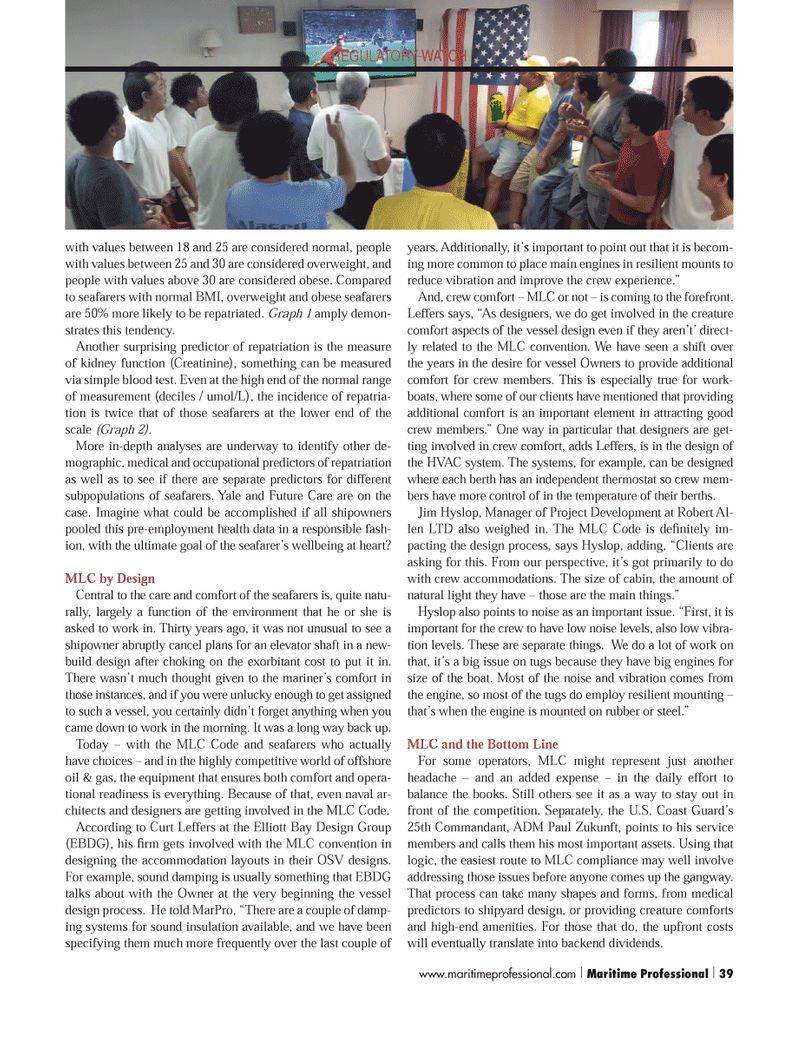
Page 39: of Maritime Logistics Professional Magazine (Q3 2014)
Power & Fuel Management
Read this page in Pdf, Flash or Html5 edition of Q3 2014 Maritime Logistics Professional Magazine
with values between 18 and 25 are considered normal, people with values between 25 and 30 are considered overweight, and people with values above 30 are considered obese. Compared to seafarers with normal BMI, overweight and obese seafarers are 50% more likely to be repatriated. Graph 1 amply demon-strates this tendency. Another surprising predictor of repatriation is the measure of kidney function (Creatinine), something can be measured via simple blood test. Even at the high end of the normal range of measurement (deciles / umol/L), the incidence of repatria-tion is twice that of those seafarers at the lower end of the scale (Graph 2) .More in-depth analyses are underway to identify other de- mographic, medical and occupational predictors of repatriation as well as to see if there are separate predictors for different subpopulations of seafarers. Yale and Future Care are on the case. Imagine what could be accomplished if all shipowners pooled this pre-employment health data in a responsible fash- ion, with the ultimate goal of the seafarer?s wellbeing at heart? MLC by DesignCentral to the care and comfort of the seafarers is, quite natu- rally, largely a function of the environment that he or she is asked to work in. Thirty years ago, it was not unusual to see a shipowner abruptly cancel plans for an elevator shaft in a new- build design after choking on the exorbitant cost to put it in. There wasn?t much thought given to the mariner?s comfort in those instances, and if you were unlucky enough to get assigned to such a vessel, you certainly didn?t forget anything when you came down to work in the morning. It was a long way back up. Today ? with the MLC Code and seafarers who actually have choices ? and in the highly competitive world of offshore oil & gas, the equipment that ensures both comfort and opera-tional readiness is everything. Because of that, even naval ar- chitects and designers are getting involved in the MLC Code. According to Curt Leffers at the Elliott Bay Design Group (EBDG), his rm gets involved with the MLC convention in designing the accommodation layouts in their OSV designs. For example, sound damping is usually something that EBDG talks about with the Owner at the very beginning the vessel design process. He told MarPro, ?There are a couple of damp-ing systems for sound insulation available, and we have been specifying them much more frequently over the last couple of years. Additionally, it?s important to point out that it is becom- ing more common to place main engines in resilient mounts to reduce vibration and improve the crew experience.? And, crew comfort ? MLC or not ? is coming to the forefront. Leffers says, ?As designers, we do get involved in the creature comfort aspects of the vessel design even if they aren?t? direct- ly related to the MLC convention. We have seen a shift over the years in the desire for vessel Owners to provide additional comfort for crew members. This is especially true for work- boats, where some of our clients have mentioned that providing additional comfort is an important element in attracting good crew members.? One way in particular that designers are get- ting involved in crew comfort, adds Leffers, is in the design of the HVAC system. The systems, for example, can be designed where each berth has an independent thermostat so crew mem- bers have more control of in the temperature of their berths. Jim Hyslop, Manager of Project Development at Robert Al- len LTD also weighed in. The MLC Code is de nitely im- pacting the design process, says Hyslop, adding, ?Clients are asking for this. From our perspective, it?s got primarily to do with crew accommodations. The size of cabin, the amount of natural light they have ? those are the main things.? Hyslop also points to noise as an important issue. ?First, it is important for the crew to have low noise levels, also low vibra- tion levels. These are separate things. We do a lot of work on that, it?s a big issue on tugs because they have big engines for size of the boat. Most of the noise and vibration comes from the engine, so most of the tugs do employ resilient mounting ? that?s when the engine is mounted on rubber or steel.? MLC and the Bottom LineFor some operators, MLC might represent just another headache ? and an added expense ? in the daily effort to balance the books. Still others see it as a way to stay out in front of the competition. Separately, the U.S. Coast Guard?s 25th Commandant, ADM Paul Zukunft, points to his service members and calls them his most important assets. Using that logic, the easiest route to MLC compliance may well involve addressing those issues before anyone comes up the gangway. That process can take many shapes and forms, from medical predictors to shipyard design, or providing creature comforts and high-end amenities. For those that do, the upfront costs will eventually translate into backend dividends. REGULATORY WATCH www.maritimeprofessional.com | Maritime Professional | 3934-49 Q3 MP2014.indd 3934-49 Q3 MP2014.indd 398/13/2014 3:08:02 PM8/13/2014 3:08:02 PM

 38
38

 40
40
